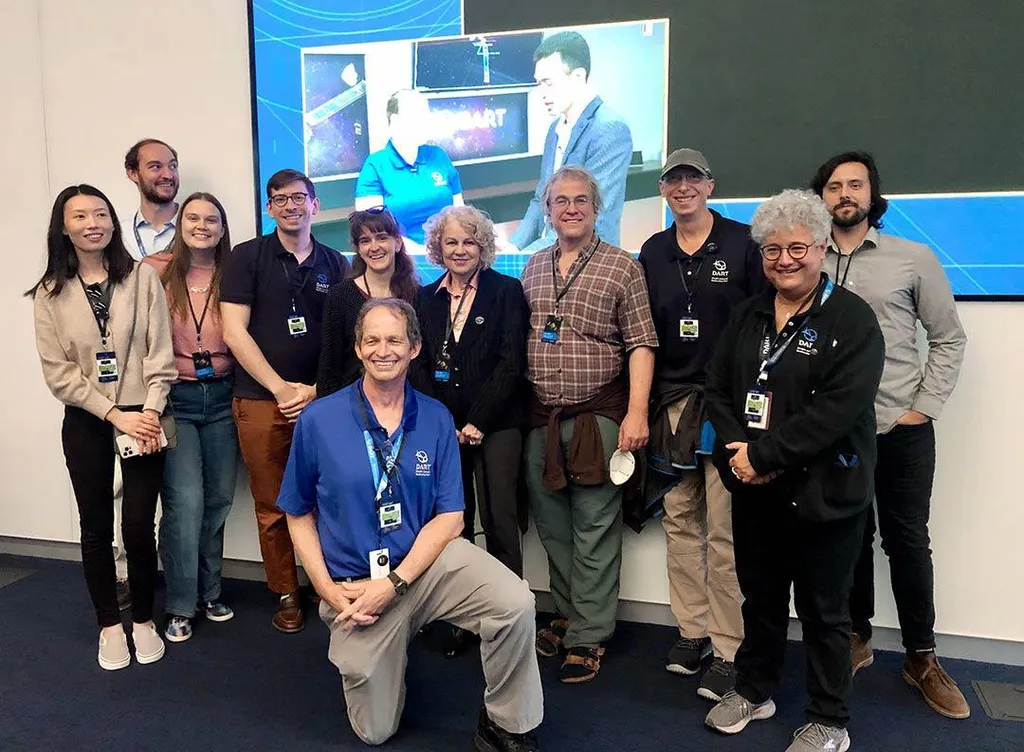- September 28, 2022
- By Chris Carroll
At first glance, a mission to slow down the orbit of a tiny moon around an asteroid millions of miles away might seem like an odd strategy to defend our planet. But developing our ability to knock large space rocks around could one day prove invaluable if we ever discover one is bound for a collision with Earth.
NASA’s DART (Double Asteroid Redirection Test) mission Monday successfully launched a 1,300-pound impactor at 14,000 miles per hour, creating a cloud of dust (or ejecta) visible from Earth and presumably putting the brakes on that asteroid moon, Dimorphos, which orbits the larger Didymos, in a big way.

The University of Maryland was at the center of the mission, with numerous faculty members playing important roles, including Derek Richardson, the DART mission lead for dynamics. Richardson is an expert in “rubble pile” asteroids—essentially jumbles of boulders and dust careening through space—and has done pioneering numerical modeling work on how impactors like the one carried by DART would affect and possibly send them into safer orbits.
He spoke to Maryland Today about risks to Earth, the excitement of the mission and UMD’s leading role in researching asteroids and other small space bodies.
Will Earth one day need to divert an asteroid? How big is the risk?
We will definitely face a potential impact that could have regional consequences at least. The day after Valentine’s Day 2013, a meteor broke up in the atmosphere above Chelyabinsk, Russia, that was just 20 meters in size. It put 1,500 people in the hospital from flying glass from the sonic wave of the detonation in the atmosphere, and some people were sunburned by thermal radiation.
We expect something of that size every 100 years or so, and something the size of Dimorphos, which is 160 meters, perhaps every 10,000 years. An impact that size would have an enormous effect, like devastating a continent, or if it hit in the ocean, creating huge tsunamis on various seaboards. We build reservoir dams to withstand 10,000-year weather events, so it makes sense to pay attention to this, too.
If we found an asteroid hurtling toward Earth, could we effectively deflect it?
I think DART has unequivocally demonstrated that we could. Of course, if it were a real threat instead of an experiment, we’d want levels of contingencies. We’d send at least two spacecraft out there, to have a backup, just in case.
So imagine we suddenly discover something dangerous coming our way—what would the response look like?
The most important thing is detection; we need to find it first, and the earlier we do, the better. We think we’ve found about 50% of those in the Dimorphos class near us. The other half we haven’t found is somewhat concerning. But we’d probably have a fair amount of warning—100 years, 10 years. It would be quite surprising if we only noticed an incoming asteroid a year out. DART—from the point it was approved for construction to impact—was three years. So in principle, we could probably do a kinetic impact like this.
If we had 50 years’ warning, we could do something called a “gravity tractor,” where you park a spacecraft in a stationary orbit next to it and its gravity slowly alters the asteroid’s trajectory. That’s the ultimate in control, because you don’t touch the asteroid.
DART obviously was designed to touch the asteroid in a big way. What happened?
We don’t know exactly yet, but we smacked Dimorphos really good. Images of the impact show a spectacular ejecta plume coming off initially that was more visible from the ground than we expected. We think there will be a crater at least 20 meters in diameter, but it’s possible it’s even bigger, or even that we changed the shape of the target so dramatically it no longer makes sense to call it a crater.
We’re expecting this experiment to slow Dimorphos’ orbit around Didymos by at least 10 minutes, but with the impact we observed, I frankly think it’s going to be quite a bit more than that.
How are you feeling after the excitement Monday?
This was my first time being this deeply involved in a mission from early on. We still have probably another year of work to do to understand exactly what happened, but it was basically as perfect as we could have hoped for. The energy of the people in the room at APL [Johns Hopkins University Applied Physics Laboratory] watching—I’ve never experienced anything like it.
Tell us more about UMD’s history with this kind of mission.
The astronomy department and our Small Bodies Group really got on the map for doing the first deliberate impact on a small body in space in the Deep Impact mission in 2005 [led by the late Professor Michael A’Hearn]. The goal there was to understand the interior of a comet, rather than deflection. The results were spectacular—the impact was so big it blinded the mother spacecraft for a while.
It generated enormous press and public interest—overwhelmed us and crashed our servers, everything. So we’re happy to be carrying on the tradition now.
Other UMD Department of Astronomy and Department of Aerospace Engineering faculty, staff and students on the DART team include:
- Harrison Agrusa Ph.D. ’22, graduate assistant (ASTR)
- Brent Barbee, lecturer (AERO)
- Tony Farnham, research scientist (ASTR)
- Douglas Hamilton, professor (ASTR)
- Christine Hartzell, associate professor (AERO)
- Carrie Holt, doctoral student (ASTR)
- Ludmilla Kolokolova, research scientist (ASTR)
- Juan Rizos, postdoctoral associate (ASTR)
- Jessica Sunshine, professor (ASTR)
- Yun Zhang, postdoctoral researcher (AERO)
Read Maryland Engineering's article about the DART mission.
